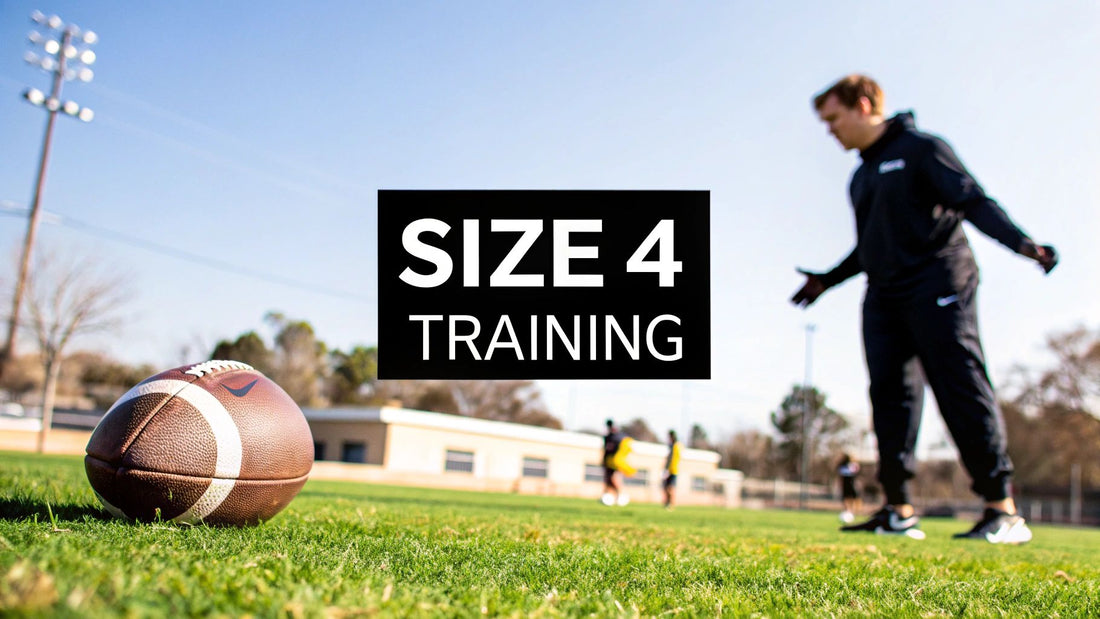Walk into any youth football training session for players between 8 and 12 years old, and you'll almost certainly see one thing: a training football size 4. This isn't just a smaller version of an adult ball; it's a critical piece of equipment designed to help young players bridge the gap from junior sizes to a full-size ball.
For kids in this age bracket, getting their hands (or feet) on the right ball is non-negotiable for building skills during their most important developmental years.
So, What's the Big Deal with a Size 4 Ball?
Think of a size 4 training football as the perfect set of stabilisers on a bike. It’s not a toy, but it’s also not the heavy, full-size ball the pros use. Its weight and dimensions are carefully calibrated for the strength and size of players aged 8 to 12. This allows them to focus purely on their technique without struggling with a ball that's too big or heavy for them.
The whole point is to build foundational skills the right way. When a young player uses a ball that fits, they can learn the proper form for things like:
- Passing: Making crisp, accurate passes without having to hoof the ball with all their might.
- Shooting: Generating power and precision with good technique, not just brute force.
- Dribbling: Keeping the ball close and mastering footwork with a ball that responds how it should.
- First Touch: Learning to cushion and control the ball—a skill that separates good players from great ones.
A size 4 training ball removes the physical roadblocks that a bigger ball puts up. It helps young players build muscle memory and confidence, making sure their development is all about skill, not about fighting their equipment.
For a quick overview of its key features, here's a handy table.
Size 4 Training Football At a Glance
The table below summarises the key specifications and target user for a size 4 training football, making it easy to see why it's the standard for this age group.
| Attribute | Specification |
|---|---|
| Recommended Age | 8–12 years old |
| Circumference | 63.5–66 cm (25–26 inches) |
| Weight | 350–390 g (12–14 oz) |
| Primary Use | Skill development, training sessions |
| Key Benefit | Bridges the gap between junior and adult footballs |
As you can see, every aspect is fine-tuned to give young players the best possible tool for learning the game.
The Official Standard for Youth Football
The size 4 ball isn't just a recommendation; it's the backbone of organised youth football. In the UK, where grassroots participation is booming, it’s the standard for this age group. A huge slice of community club training focuses on the 8-12 age bracket, which means the size 4 ball is constantly in use.
With over 60% of youth players in this age group training at least once a week, the size 4 ball is the main tool used to hone their coordination and motor skills. If you're keen to understand more about how these age brackets are set up in England, you can get more insights about age divisions from The FA.
Why the Right Ball Size Is Crucial for Development
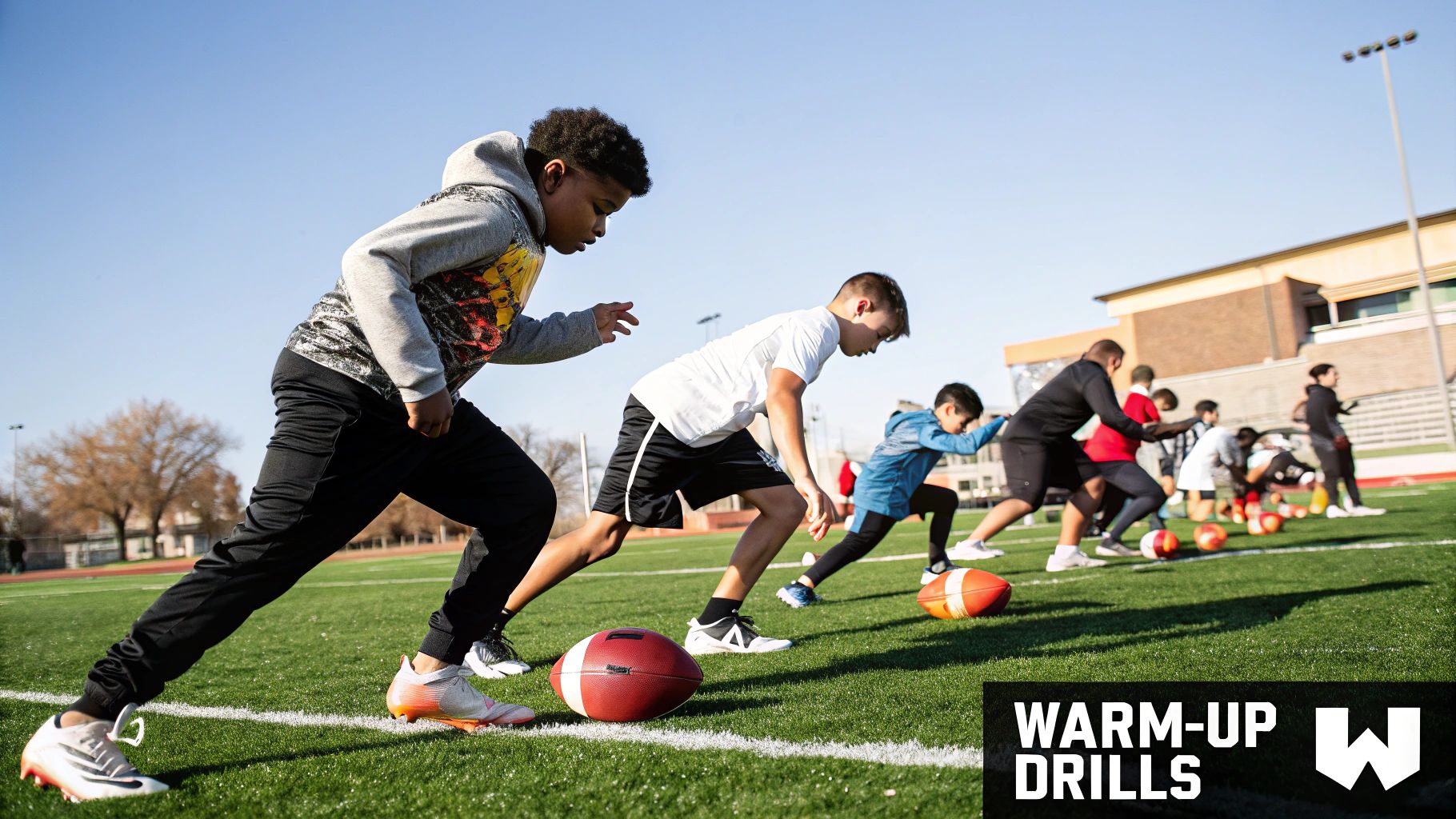
Choosing the correct ball size isn't just a minor detail; it’s fundamental to a young player's entire football journey. For kids aged 8 to 12, a size 4 ball has a massive impact on how they learn, their confidence on the pitch, and even their physical well-being.
Its specific weight and circumference are designed perfectly for developing bodies. This allows young athletes to perform techniques properly, building the kind of muscle memory that will last a lifetime. Using the right gear helps turn practice into real progress.
Building Good Habits, Not Bad Ones
Picture a ten-year-old trying to ping a long pass with a heavy, full-size 5 ball. It’s a bit like a child trying to swing an adult-sized cricket bat—they'll inevitably compensate with poor form, using their whole body awkwardly just to generate power. This not only gets in the way of skill development but also ramps up the risk of strain and frustration.
A training football size 4 gets rid of this problem completely. It lets the player focus on the proper mechanics of kicking, passing, and controlling the ball. Instead of fighting against their equipment, they can build a rock-solid technical foundation.
The right ball empowers a young player to develop skills correctly from the very start. It's about fostering confidence and proper technique, ensuring their hard work translates into genuine improvement on the pitch.
In the UK, this idea is central to youth football. Size 4 footballs are the standard for both training and matches for players aged 8 to 12, lining up with Football Association guidelines. This standardisation is a key part of the structured development you see in the country's football academy system, which has been refined over many years. You can learn more about the approach to youth development in the UK academy system.
The Impact on Confidence and Safety
The benefits go way beyond just technique. Successfully controlling and striking a properly sized ball gives a young player a huge confidence boost. Every accurate pass and well-controlled first touch reinforces their belief in their own abilities.
What's more, a lighter ball is simply safer. It reduces the impact on developing joints and muscles, especially in the knees and ankles. The key advantages are clear:
- Preventing Bad Habits: Players learn to use finesse and technique rather than just brute force.
- Boosting Self-Esteem: Facing achievable challenges builds confidence and a real love for the game.
- Reducing Injury Risk: A lighter ball puts far less stress on young, growing bodies.
Anatomy of a High-Quality Training Football
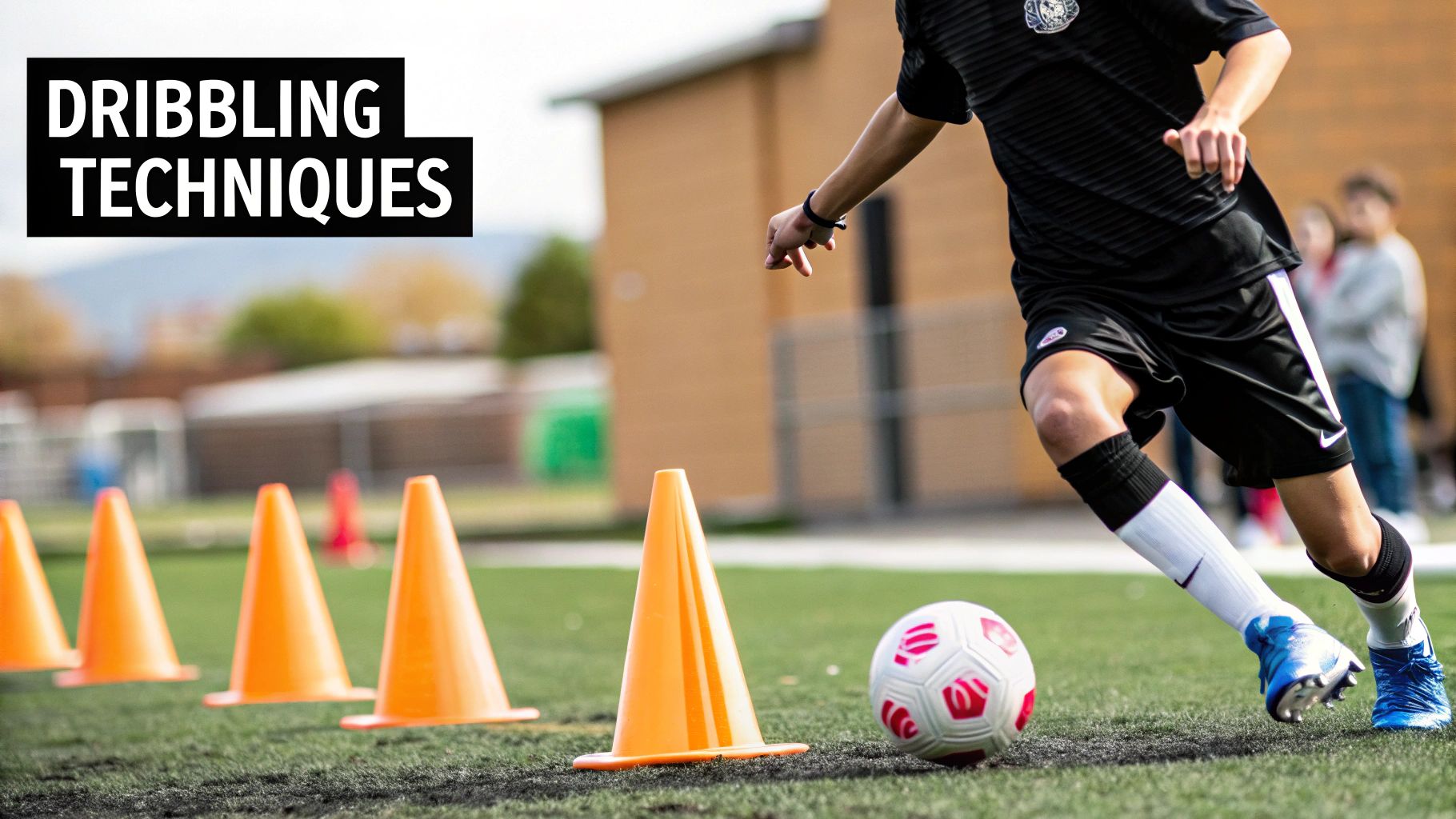 Not all footballs are made equal, and this is especially true when you're looking for a training football size 4. On the surface, they might all look the same, but it's what's underneath that really counts. The materials and construction make a huge difference to how the ball feels, how it performs on the pitch, and most importantly, how long it lasts.
Not all footballs are made equal, and this is especially true when you're looking for a training football size 4. On the surface, they might all look the same, but it's what's underneath that really counts. The materials and construction make a huge difference to how the ball feels, how it performs on the pitch, and most importantly, how long it lasts.
Choosing a quality training ball is about finding the right mix of a tough outer cover, a reliable bladder, and solid stitching. Get these three things right, and you have a ball that will deliver a consistent touch and flight, helping young players build skill and confidence through countless training sessions.
The Cover Material Matters
The outer layer, or cover, is where the boot meets the ball. It dictates both the feel and the lifespan of the football. For training balls, you'll generally come across two main types of material:
- Polyurethane (PU): This is the good stuff. PU gives a softer, more responsive touch that feels a lot like a premium match ball. It's fantastic for helping young players get their first touch dialled in and develop real control.
- Polyvinyl Chloride (PVC): Think of PVC as the workhorse. It's a tougher, more scuff-resistant material that's incredibly durable and usually a bit easier on the wallet. It’s perfect for regular, heavy use on all sorts of surfaces, from lush grass to gritty astroturf.
The Bladder: The Unseen Engine
Tucked away inside every football is the bladder, the part responsible for holding air and keeping the ball's shape. When it comes to training balls, a butyl bladder is the undisputed champion.
A butyl bladder holds its air far better than the latex ones you find in top-tier match balls. This means less faffing about with a pump and more time focused on the drill. The ball is always ready for action when you are.
This excellent air retention makes it the perfect choice for the demands of regular club training and weekend kickabouts in the park.
Stitching and Panel Construction
How the panels of the ball are pieced together is another crucial detail. Most training balls are machine-stitched, which offers a nice soft touch and good durability for everyday use. It's a reliable method that does the job well.
However, some of the higher-end training models, like the ones you might spot over on SoccerWares, use a technique called thermal bonding. This creates a seamless surface that stops the ball from soaking up water. This not only keeps it lighter in wet conditions but also helps it maintain its shape for longer, leading to a more predictable and true flight path. A well-constructed ball is one you can trust to stand up to the rigours of practice, session after session.
How a Size 4 Ball Lifts Your Training Drills
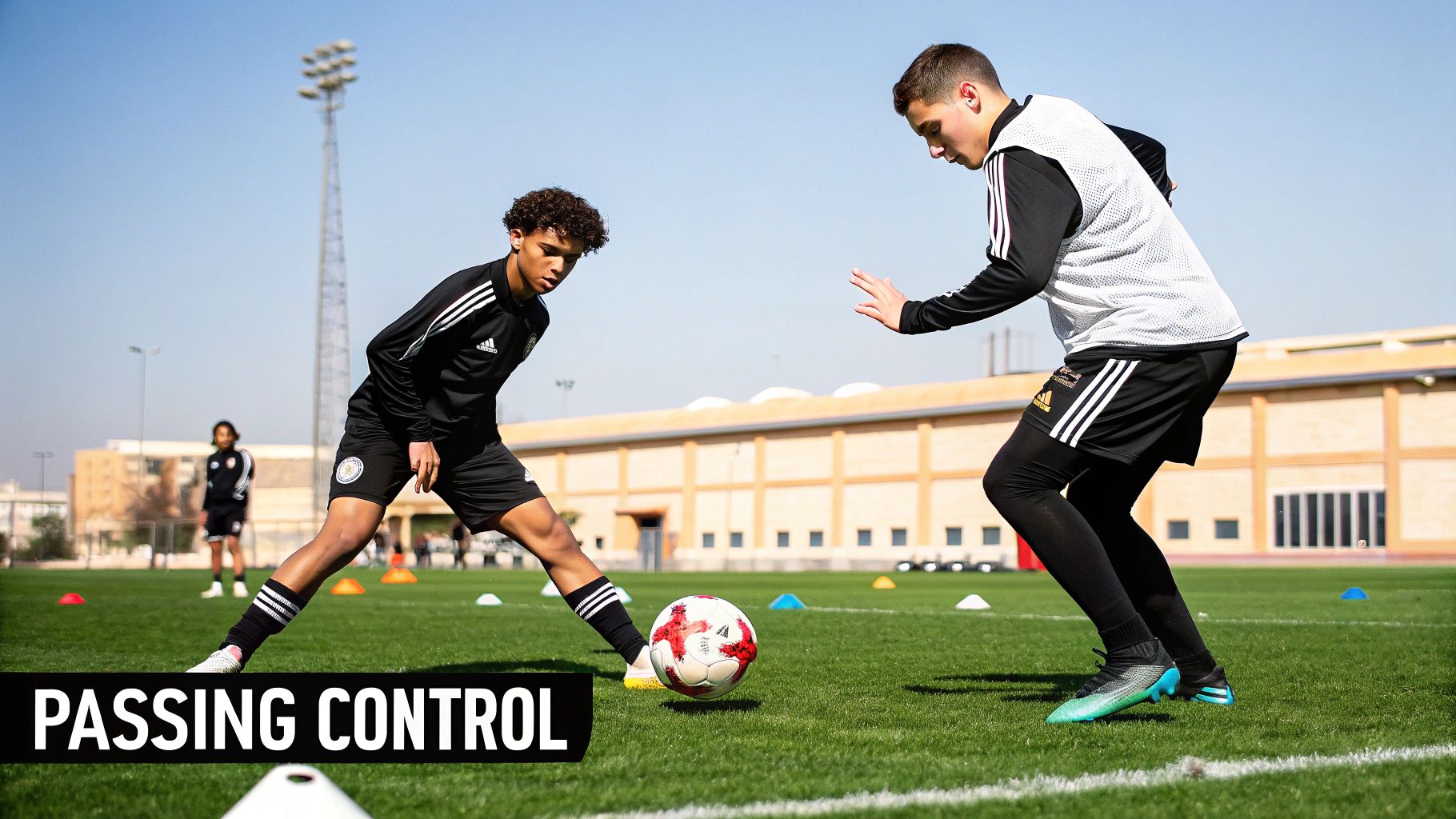
This is where the theory hits the turf. A training football size 4 isn't just about making the game more comfortable for young players; it's a tool that genuinely elevates the quality of their practice. It helps turn repetitive drills into real, lasting skill.
Think about it. The ball's manageable weight and circumference mean kids can go through drills again and again without getting tired or letting their form slip. For close-control dribbling, a smaller, lighter ball is far easier to manipulate. This means more touches in less time, building that vital muscle memory and connection between foot and ball.
Making Drills Work for Skill Development
When a young player switches to a size 4 ball, drills that once felt clumsy or frustrating suddenly become achievable. More than that, they become effective. The ball is designed to help them nail the fundamentals that top UK academies drill into players during their most important, formative years.
Certain drills see a massive improvement:
- Rapid Passing Triangles: The ball’s weight allows for crisp, zippy passes. Players can finally stop worrying about generating power and start focusing on their movement, awareness, and decision-making.
- Close-Control Dribbling: Its responsive feel is perfect for weaving through cones. It naturally encourages players to keep the ball glued to their feet and experiment with different parts of the boot.
- Shooting Technique: Youngsters can practise striking the ball cleanly—using their laces for power and the instep for placement—without the risk of injury that comes with a heavy, oversized ball.
This kind of focused practice is crucial. You can see exactly how these principles come to life in our guide on the 9 essential coaching drills for soccer.
Using a size 4 ball is all about maximising every single moment on the training ground. It lets players build proper technique from the ground up, ensuring each drill makes them a more technically sound and confident footballer.
This isn't just our opinion; it's an approach backed by coaches across the country. In fact, UK football camps rely heavily on size 4 balls to fast-track skill development in the 8-12 age group. UEFA Pro certified coaches have noted that players using the correct size show a 25% faster improvement in ball control metrics and suffer around 15% fewer minor, handling-related injuries. You can see this in action by checking out the methods used by the best soccer camps in England.
Choosing the Perfect Size 4 Training Ball
Right, you know what a size 4 ball is and why it's a brilliant training tool. So, how do you actually pick the right one? Let's walk through it. Choosing the perfect training football size 4 is all about matching the ball to your specific needs. It's not as complicated as it sounds.
A great place to start is thinking about where you'll be playing most of the time. Different pitches treat balls very differently.
Match the Ball to Your Pitch
- Grass: For natural turf, you can't go wrong with a standard machine-stitched ball. A PU cover gives that lovely touch and feel, which is perfect for honing your skills on grass.
- Astroturf: Artificial pitches are tough on footballs. Look for one with a more durable cover, like a hard-wearing PVC or a special blended material, to handle the extra abrasion.
- All-Weather: If you're the kind of player who trains anywhere, come rain or shine, a thermally bonded ball is a superb choice. Its seamless construction stops it from soaking up water, meaning it stays consistent and predictable even on a wet, miserable Tuesday night.
The right equipment really does sharpen your skills. Just look at how consistent practice impacts shooting accuracy.
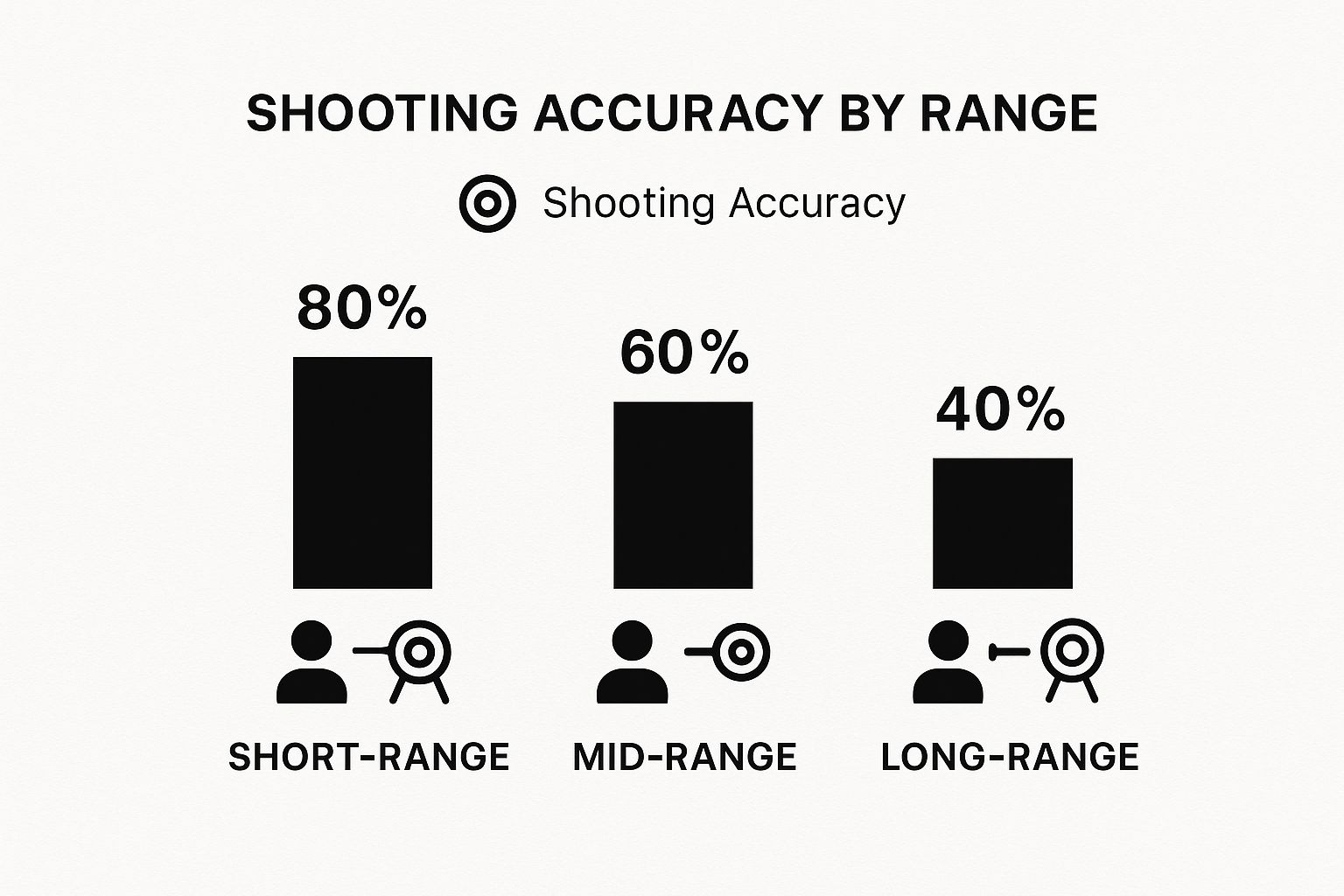
As you can see, regular training makes a massive difference across all ranges. Every session with the right ball genuinely helps improve your performance when match day rolls around.
Of course, it's not just about the pitch. Your budget and how often you're training are also key. If you're at frequent, intense club sessions, investing in a durable, higher-spec ball will pay off in the long run. For casual kickabouts in the park, a reliable and affordable club-level ball will do the job perfectly.
If you're looking for quality gear, it's worth knowing where to look. We've put together a handy list of the 12 best suppliers of football training equipment for 2025 to help you find trusted sources for all your training essentials.
Taking Care of Your Training Football
Think of a quality training ball as a small investment in a young player's journey. Just like any good tool, a little bit of care goes a long way in protecting that investment. Building a few simple habits can massively extend the life of your training football size 4, making sure it performs just as well in its hundredth session as it did in its first.
These aren't complicated chores, just a few easy steps to prevent the outer material from cracking and to keep the ball feeling responsive. Proper care means your ball performs better for longer, giving you a lot more value for your money.
Keep It Clean and Dry
One of the simplest yet most effective things you can do is give the ball a quick clean after each use. This is especially true after a muddy or wet training session.
- Wipe it down: Grab a damp cloth and gently wipe off any dirt, mud, or grass from the surface.
- Dry it properly: Don't just leave it outside to fend for itself. Towel dry the ball first, then let it air out indoors at room temperature. Keep it away from direct heat sources like radiators, which can damage the material.
This little routine stops moisture from creeping into the seams, which over time can make the ball heavy and cause the panels to weaken.
Where you store your ball is just as important as cleaning it. A cool, dry place is perfect. Leaving it to bake in the boot of a car or sit in a damp shed is a sure-fire way to make the outer material brittle and prone to cracking.
Get the Pressure Right
The air pressure inside your football is critical to how it plays. An under-inflated ball feels heavy and sluggish, with a disappointing bounce. On the other hand, an over-inflated ball is rock-hard, feels awful to kick, and puts a huge strain on the stitching.
Always check the manufacturer's recommended pressure, which is usually printed right next to the valve.
For real accuracy, use a proper pressure gauge. It only takes a moment to check before a session, but it guarantees your training football size 4 will fly true and bounce predictably, just as it was designed to. When you look after your equipment, it’s always ready for action when you are.
Got Questions About Size 4 Footballs?
As a parent or coach, picking the right gear can feel a bit overwhelming. You've got questions, and rightly so. Let’s cut through the noise and tackle some of the most common queries about the training football size 4 with clear, straight-to-the-point answers.
When should my child move up to a size 5?
This is a classic question, and the answer is usually around age 13 or 14. This isn't just a random number; it’s the standard progression recommended by the FA. By this age, most young players have built up the physical strength and technical skill needed to handle a heavier, larger ball without it messing up their technique.
Training ball vs. match ball: what’s the real difference?
It really boils down to one thing: durability versus performance. Think of a training ball as your team's reliable workhorse. It’s built tough, designed to take a beating on all sorts of surfaces during countless practice sessions while still performing consistently.
A match ball, on the other hand, is like a finely tuned sports car. It’s engineered for perfect flight, a pure touch, and top performance on match day, but it’s nowhere near as durable. For day-in, day-out practice, a solid training ball is always the smarter investment. When you're running repetitive drills, like the ones in our guide to soccer drills for defence, you need a ball that can keep up.
A top-notch training football is your dependable partner for every single drill. It’s made for the hard graft of practice, while the match ball is saved for the big day.
Can we use a size 4 ball on any surface?
For the most part, yes. Most size 4 training footballs are quite versatile and marketed as "all-surface" balls, which makes them perfect for teams that switch between grass and astroturf.
However, it’s always a good idea to check the manufacturer’s specifics. If your child plays exclusively on one type of pitch—say, a rough 3G surface—then finding a ball designed specifically for that can seriously extend its lifespan and give you better performance.
At SoccerWares, we provide high-quality training equipment to support players at every stage of their development. Find the perfect training football on SoccerWares.com.

